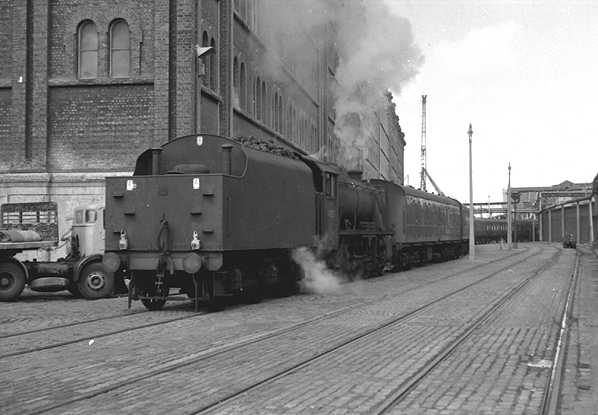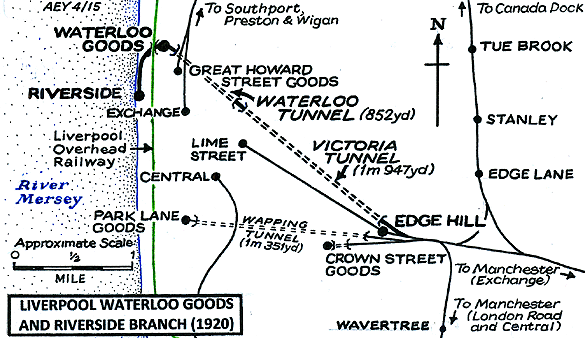
THE LIVERPOOL RIVERSIDE &
|
Notes: To connect the Liverpool Riverside station to the main line of the Mersey Docks & Harbour Board (MD&HB) and also to the nearest main line at the London & North Western Railway (LNWR) Waterloo goods station required the laying of a line 48 chains in length. From the northern end of Riverside station to Waterloo the line was entirely on street in tramway style (with groove and outer flange). The rails used were of a slightly heavier dimension than on the typical street tramways because of the weight they were expected to carry. The type of rail was specially manufactured for the MD&HB whose extensive railway network was laid in this way.
From Liverpool Riverside the line ran north for a short distance parallel to the Princes Dock as a double track formation. It then curved towards the north-east and crossed a swing bridge. The swing bridge carried the line over the Princes Dock. The bridge was controlled by semaphore signals for both trains and shipping. A 3-lever Railway Signal Co ground frame controlled a bridge lock and protective signals either side of the bridge. After crossing the bridge the line continued in a north-easterly direction and then curved northwards at the point where it met the north/south MD&HB dock railway ‘main line’. Before it reached the ‘main line’ it became single track. At this location standing directly above the ‘main line’ was the Princes Dock Liverpool Overhead Railway station. It ran parallel to the main line for a short distance and then connected to it at a point just south of the Waterloo goods station. A spur ran from the MD&HB line and crossed Waterloo Road and then ran into the goods station. The crossing over Waterloo Road was controlled by semaphore signals on each side of the road. The speed limit on the line was 5mph and all trains had to be preceded by a pilotman who walked in front with a red flag. That way of working continued throughout the life of the line. Only during the two world wars was the method of working altered due to the very heavy traffic in troop trains. To allow more trains to run railway employees were positioned along the length of the line. The intention of the MD&HB was that any railway company could have access to Riverside station. Other than the LNWR only one other company expressed an interest and that was the Great Northern Railway. They ran a train from Kings Cross to Riverside via their connection with the MD&HB railway at Brunswick. Like the Riverside line the ‘main line’ of the MD&HB was restricted to 5mph. From Brunswick to Riverside is nearly 3 miles. This speed restriction made the operation of the GNR train very slow and it was not repeated, leaving the Riverside line to the LNWR as far as passenger services were concerned. The LNWR became part of the London Midland & Scottish Railway (LMS) at the Grouping of 1 January 1923. The LMS continued to operate trains to and from Liverpool Riverside just as the LNWR had done - as did British Railways after nationalisation on 1 January 1948. The 1937 LMS working instructions for the branch (seen below) describe how trains had to be worked along the branch.
The weight restriction on the swing bridge and the tight curves along the line had been a serious constraint ever since it had opened. In 1949 consideration was given to strengthening the bridge and to easing the curves so that main line locomotives could run into Liverpool Riverside. In October 1949 a ship ran into the bridge causing extensive damage. As it needed major repairs the decision was taken to strengthen it at the same time as easing the curves, and in this process the double track section had to be converted to a single-track railway (the down line being lifted). The works were completed by March 1950 and from that date main line locomotives started to run. Towards the end of the 1950s the trans-Atlantic liner trade began to decline as air travel became more common. By the end of the 1960s only a few trains were running each week and the last train ran between Riverside and Waterloo on 25 February 1971. In 2015 sections of the line could still be seen. See also: Liverpool Riverside, Waterloo Goods Station and
|

Photo by Chris Coulter from his Flickr photostream
.jpg)
Photo by Paul Wright
| Last updated: Sunday, 21-May-2017 14:32:53 CEST |
© 2004-2015 Disused Stations
|



 Home Page
Home Page